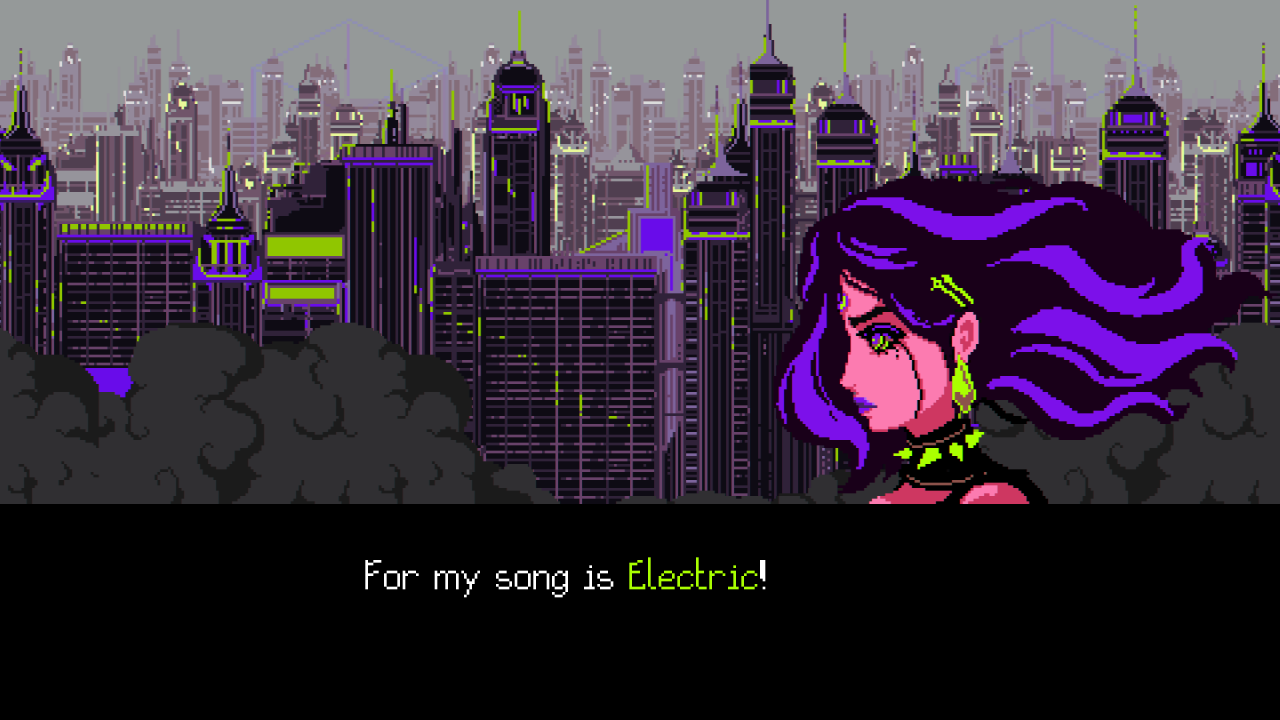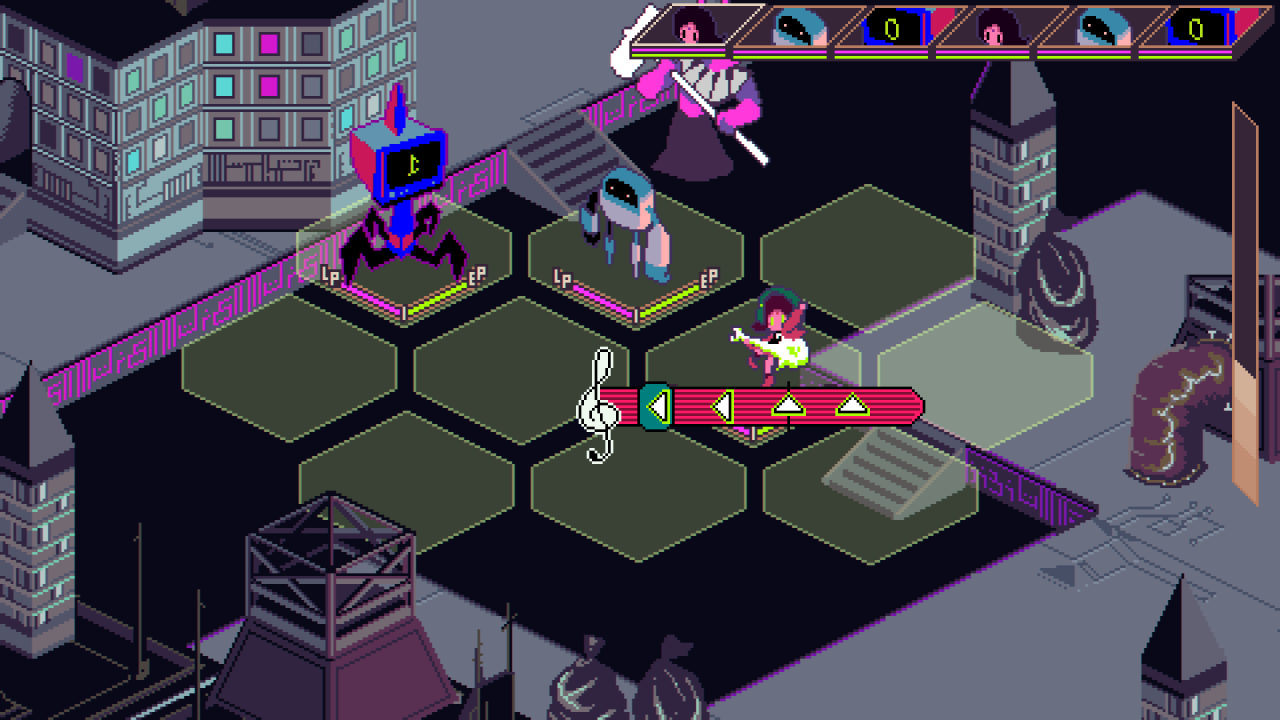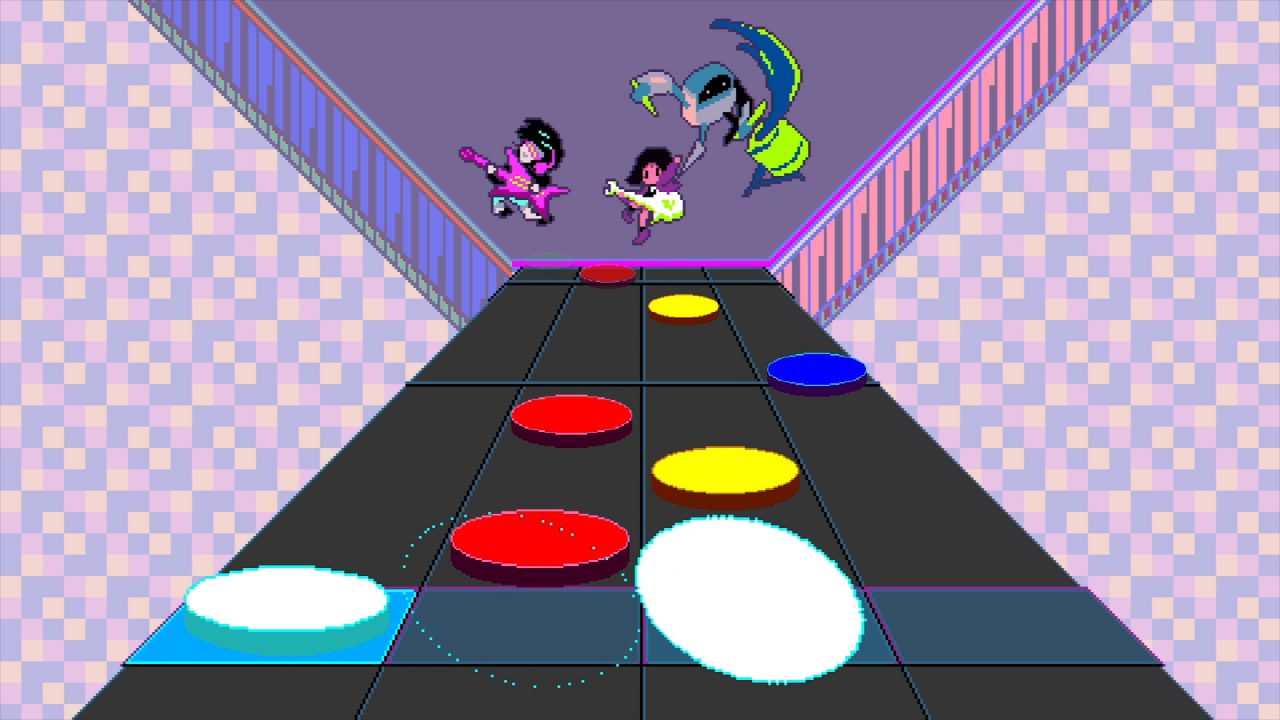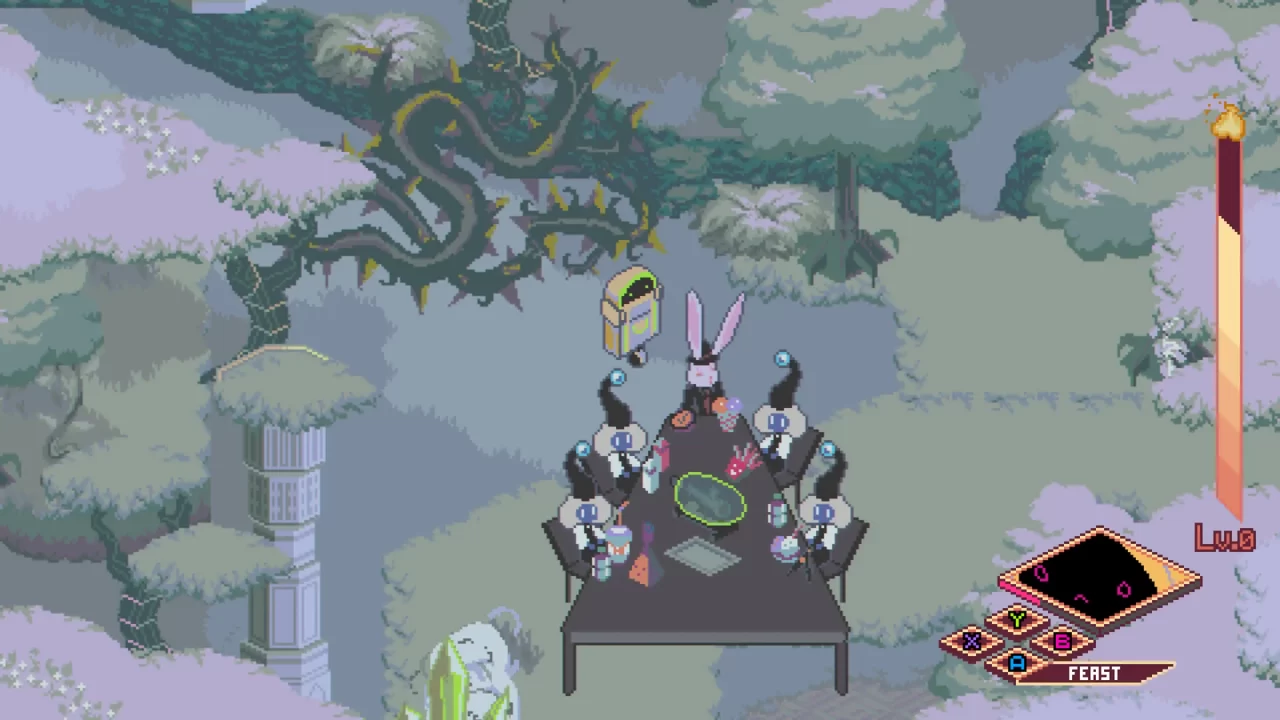Keylocker Review | RPGFan


Keylocker comes at you with the energy of a late-night movie on an obscure cable channel. The neon-drenched visuals remind me of low-budget independent science fiction, which attracted me to its lurid glamour in the first place.
This energy forms the foundation of the game, which, like many of its strange cast of characters, appears to be something of a hybrid creature. Keylocker takes the body of a turn-based JRPG and shocks it to life with the electrified stylings of a rhythm game, and the creation that staggers forth makes for an interesting beast.
Keylocker opens on a colonized Saturn, where music is banned for all but a select few and its usage strictly controlled. In this world, music generates power, and whoever possesses that resource shapes the course of life and death for the inhabitants. Here we meet our main character, Bobo, a renegade who refuses to obey the tenets of her society and continues to rock out with her band, for which Saturn’s rulers imprison her. She escapes with the aid of her “doppelgänger” brother, Dealer, a Hacker who also operates on the wrong end of legality, but they soon recapture her. Bobo’s oppressors throw her down from the lofty heights she ascended to and she lands back in the Scrapyard, the litter-strewn territory where she grew up. Here, she accidentally falls on a powered-down robot “jukebot,” which she names Rocket after a timely resurrection. Together, Bobo and Rocket set out to teach her people the futility of trying to silence the song of a society. They journey through a computerized land of cyberpunk androids, bizarre machinery, and suspicious surgery.

Keylocker encourages you to develop your own style of play, allowing you to choose between four different character classes: the offensive options Juggernaut and Hacker, and the defensive choices of Samurai and Sequencer. I picked Samurai, mainly due to the art, which depicts Bobo as a cyber-warrior, looking as cool as liquid nitrogen.
Keylocker’s combat system differs from your standard turn-based RPG. It presents you with a hexagonal grid upon which your characters rest. You must concentrate on two main bars to maintain your band of rebels: your health, represented by Life Points (LP), and Electricity Points (EP), which function a bit like magic. The turn order sits at the top of the screen, similar to titles such as Trails, but there is no interrupting the flow of events here.
In battle, moving to find optimal positioning is crucial, as each available move has a different range — usually one or two hexagons — and varies in shape. Some moves lash out in a straight line, others in a curved arc, while a few have an all-around area of effect. You have four basic actions: a straightforward attack, a move that charges your EP, a blow that steals EP from your opponent, and a defensive move that sets you up to counterattack anyone in range who dares to strike you. The enemy has essentially the same options as you. You can charge up your attack and defense using EP, and the more you put in, the more powerful your attack or potential counterattack. When attacking, the game encourages you to bet it all, as not doing so can make you momentarily vulnerable. Your equipped weapons govern the strengths and weaknesses of your moves, which come in expected forms such as swords, but also more unusual types like guitars and drums. A satisfying thrum of strings or pounding percussion accompanies strikes made with these instruments.


This brings us to the heart of Keylocker, the CPU that keeps this digital world dancing. Keylocker has rhythm-based combat. During your attack, the character flashes white, indicating that you need to press a button with split-second timing to prevent the strike from being less effective. Conversely, when fending off the more nefarious denizens of Saturn, you must time your button press precisely, which, if successful, negates all damage. Mistime it and you’re in for some pain; miss entirely, and you’re frazzled. Keylocker offers three difficulty settings, which reduce or increase the damage taken by a failed block, but even on the lowest difficulty, do not expect an easy ride. The unforgiving nature of Keylocker requires you to be attuned to the action. It’s all too simple to miss an enemy’s upcoming attack in the turn order, leaving you flailing at the controls and watching as Bobo and chums head for another imminent reboot.
This rhythm-based system leads to equal parts joy and frustration. Hitting perfectly timed attacks or counters sends a jolt of pleasure through your system, but coming up against new foes always requires a period of adjustment to learn their patterns. How much you enjoy this depends on personal preferences: do you appreciate the need to be an expert at a game’s mechanics, or do you crave progression?
Keylocker introduces an extra mechanic for its boss fights, and I would advise you to pay close attention, as approaching the bosses in the wrong way prevents you from dealing damage to them, leaving you in for an extended battle.
This leads to part of my issue with Keylocker. Aside from the above, you learn several complicated and unintuitively named underlying mechanics almost exclusively from written tutorials that can be hard to keep track of. Some of these relate to battle, but others, such as the Grand Theft Auto-like meter that increases the authorities’ level of search for Bobo, remain unexplained and seem left for you to decipher alone. You earn keys in combat which unlock class-based abilities on the finicky skill tree. Some earned abilities cause tiles to be covered in status effects after a strike, but the random nature and its links to the opaque skill tree can lead to difficult situations when fighting. For instance, one of your characters may use an ability that causes the rest to attempt to flee its consequences. It makes effective strategizing a little difficult.
A selection of mostly great minigames round out the gameplay, ranging from a simple rhythmic computer hacking minigame to a challenging and enjoyable Guitar Hero-inspired affair. A lengthy minigame involving a sword-equipped Rocket swiping at bad guys as they explode into bullet hell around him provides more fun and evolves each time you encounter it.


As for Keylocker‘s characters, expressive portrait art adds to their appeal. However, although Bobo and Rocket get multiple expressions, most other characters do not: a missed opportunity in a game that relies so heavily on narrative. Additionally, the still cutscene images do not match the style used for the profiles, making the experience a little discordant. There’s no denying these images’ effectiveness on their own merits, with wonderfully deranged portraits of the bosses appearing on screen at crucial moments.
This strangeness powers Keylocker’s story and setting, and forms one of its strongest elements. From the futuristic hustle of the city level to a deteriorating digital forest, the environments draw you in, along with the bizarre characters. Pyramid-headed clerics and talking walruses greet you. Djinns with padlocks for heads and all manner of other oddities inhabit a space quite unlike any I’ve encountered before. The themes of rebellion against state oppression and individual expression run through the game like silicon through a computer chip.
The writing does not live up to the imaginative surrounds, though. It never seems to be able to decide if it wants to be a deadly serious exploration of these themes, or a darkly comic take on them. Characters lack complexity and seldom act consistently, with ineffective plotting, in an overly discursive way, leaving me wishing that some characters would just stop talking. I never grew attached enough to any of them to care when events overtook them. Despite this, Keylocker never bored me. The sheer weirdness of everything pulled me through to the end.


But reaching that end can be challenging. I occasionally found progression gated by obtuse requirements, so much so that when I hit a game-breaking bug, I suspected my own failure to identify an obscure clue was the problem. I resolved the issue by loading an earlier save, but it did cost me a fair amount of lost time.
Finally, the music. As you would hope for such an auditory-heavy game, Keylocker is overclocked in this department. The goth rock compositions accompanying Bobo’s performances, magnificently performed by Psamathes, make the game worth the entry price. Keylocker provides a diverse offering, from metal to the appropriately electronic. Bombastic orchestral music accompanies the arrival of characters like the Prince, with operatic vocals featuring in some fights and events. I am full of admiration for the sheer quality and variety of composition. I was also won over by the effective sound design, with the noise of water when you walk close to rivers and other ambient effects working especially well through headphones.
As eclectic as its soundtrack, Keylocker has much to love, though with an underlying narrative experience that can be lacking, I can’t recommend the game to everyone. But the superb musical performances and the compelling oddity of it all are good reasons to consider downloading yourself into this flawed but unique adventure.













